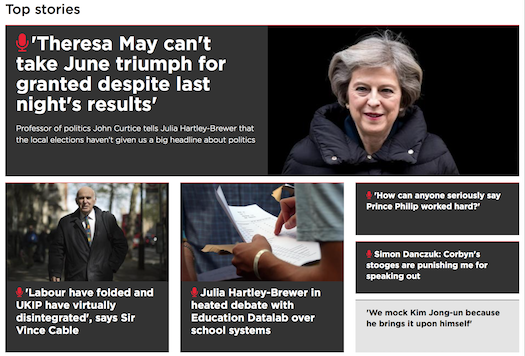Radio Tomorrow with James Cridland
I’ve been thinking of a different type of newspaper website.
Along the top navigation bar you’d find a section detailing all the journalists. You could read their biographies, and see photographs of them.
There would be a full section talking about where you could get the newspaper. Probably a list of different stores, maybe a nice map.
There would be a competition section, because it’s the internet, and you can earn money this way.
There would probably be the option of joining up to the newspaper’s VIP club, for reasons that are relatively unclear.
The front page might contain a link to the big story that week: and perhaps an updated weather forecast; but nothing particularly more. There might be an image carousel with a nice photo of the guy that puts page 2 together.
On the right-hand side would probably be an embedded Facebook page with links to the newspaper’s website on it, and below that, an embedded Twitter feed with the same links to the newspaper’s website on it worded in a slightly different way.
And if you look closely enough, you might see a link marked “Read Now”. This link would take you to a PDF of the newspaper, which would open up and allow you to read the latest issue. You couldn’t share any story from it; you couldn’t click through and discover more information about any particular story either: but you can read the paper in its original format.
This sounds rubbish, doesn’t it?
This, of course, is the standard idea of a radio website. A few links, some DJ biographies, a VIP club. And the audio equivalent of a PDF file – a live stream.
You can’t share any piece of the audio from a live stream; you can’t click through and discover more information about anything you listen to; but you can listen to the radio in its original format.
I’m increasingly impressed at stations doing more than this – recognising that to make the best of the interactive world that the internet offers, you need to be doing more than just a live stream.
The UK’s talkRADIO website, as one example, offers lots of pieces of dis-aggregated content from the front page. You quickly understand what the station’s all about, and on your interactive device you can click to listen to any part of their output.
The US’s WNYC gives you something similar. Yes, it’s small chunks of news output much like talkRADIO, but done in a way that conveys the station’s content and context.
Of course, NPR goes one further, with their NPR One service. That gives you a non-stop stream of things you might be interested in: very different to a non-interactive stream that you can’t influence.
A live stream is a lovely thing, and there is an audience for it. But just as newspapers moved away from just dumping a PDF of their latest issue on their website, perhaps it’s time for more radio stations to do something that takes advantage of what the internet’s capable of, rather than simply the audio-equivalent of a PDF file.
About The Author
 James Cridland is a radio futurologist: a writer, speaker and consultant on the effect that new platforms and technology are having on the radio business across the world.
James Cridland is a radio futurologist: a writer, speaker and consultant on the effect that new platforms and technology are having on the radio business across the world.
He writes for publications across the world, and runs media.info the worldwide media information website. He also runs a free weekly newsletter with news of radio’s future.
British by birth, James lives in Brisbane, QLD and is a fan of craft beer.

